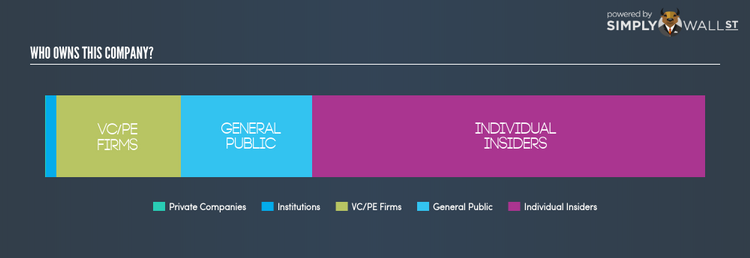Who Are The Major Shareholders In XMH Holdings Ltd (SGX:BQF)?

Today, I will be analyzing XMH Holdings Ltd’s (SGX:BQF) recent ownership structure, an important but not-so-popular subject among individual investors. A company’s ownership structure is often linked to its share performance in both the long- and short-term. Since the same amount of capital coming from an activist institution and a passive mutual fund has different implications on corporate governance, it is a useful exercise to deconstruct BQF’s shareholder registry. All data provided is as of the most recent financial year end.
Check out our latest analysis for XMH Holdings
Institutional Ownership
Due to the big order sizes of institutional investors, a company’s shares can experience large, one-sided momentum, driven by high volume of shares removed from, or injected into, the market. With an institutional ownership of 1.63%, BQF doesn’t seem too exposed to higher volatility resulting from institutional trading. Stocks with low coverage such as BQF, attracts renowned investor Peter Lynch, who has benefited from the momentum of institutions buying into a stock as it gained popularity.
Insider Ownership
Another important group of shareholders are company insiders. Insider ownership has to do more with how the company is managed and less to do with the direct impact of the magnitude of shares trading on the market. BQF insiders hold a significant stake of 59.38% in the company. This level of insider ownership has been found to have a negative impact on companies with consistently low PE ratios (underperformers), while it has been positive in the case of high PE ratio firms (outperformers). It’s also interesting to learn what BQF insiders have been doing with their shareholdings lately. Insiders buying company shares can be a positive indicator of future performance, but a selling decision can simply be driven by personal financial needs.
General Public Ownership
A big stake of 19.96% in BQF is held by the general public. With this size of ownership, retail investors can collectively play a role in major company policies that affect shareholders returns, including executive remuneration and the appointment of directors. They can also exercise the power to decline an acquisition or merger that may not improve profitability.
Private Equity Ownership
With an ownership of 18.80%, private equity firms are a major stakeholder in BQF and are in a position to play an important role in shaping up corporate strategy with a focus on value creation. This is a positive sign for potential investors as these firms play an important role in aligning company policy with shareholder returns.
Private Company Ownership
Another group of owners that a potential investor in BQF should consider are private companies, with a stake of 0.0023%. While they invest more often due to strategic interests, an investment can also be driven by capital gains through share price appreciation. However, an ownership of this size may be relatively insignificant, meaning that these shareholders may not have the potential to influence BQF’s business strategy. Thus, investors not need worry too much about the consequences of these holdings.
What this means for you:
Institutional ownership in BQF is not at a level that would concern investors. We are less likely to see sustained downtrends or significant volatility resulting from large institutional trading. However, ownership structure should not be the only focus of your research when constructing an investment thesis around BQF. Rather, you should be examining fundamental factors such as XMH Holdings’s past track record and financial health. I urge you to complete your research by taking a look at the following:
1. Financial Health: Is BQF’s operations financially sustainable? Balance sheets can be hard to analyze, which is why we’ve done it for you. Check out our financial health checks here.
2. Past Track Record: Has BQF been consistently performing well irrespective of the ups and downs in the market? Go into more detail in the past performance analysis and take a look at the free visual representations of BQF’s historicals for more clarity.
3. Other High-Performing Stocks: Are there other stocks that provide better prospects with proven track records? Explore our free list of these great stocks here.
NB: Figures in this article are calculated using data from the last twelve months, which refer to the 12-month period ending on the last date of the month the financial statement is dated. This may not be consistent with full year annual report figures.
To help readers see pass the short term volatility of the financial market, we aim to bring you a long-term focused research analysis purely driven by fundamental data. Note that our analysis does not factor in the latest price sensitive company announcements.
The author is an independent contributor and at the time of publication had no position in the stocks mentioned.

